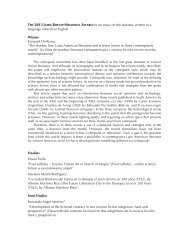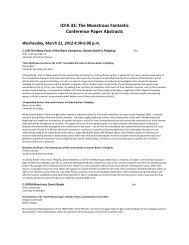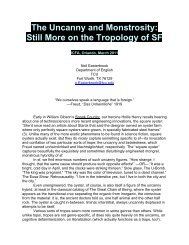98. (F/SF) Medieval Tales Re-told Captiva BChair: Timothy H. EvansWestern Kentucky UniversityThree Monsters in Transformation: Grendel, Grendel’s Mother, and the Dragon of Michael Crichton’s Eaters of the DeadMarie NelsonUniversity of Florida<strong>The</strong> dragon of John Gardner’s Grendel had it right when he told Grendel the reason for his existence was to scare men to glory, but he couldhave added that to succeed the monster had to be sufficiently fear inspiring — or monstrous — to accomplish his purpose. This reading ofMichael Crichton’s re-telling of the Beowulf story with reference to parallels from his source gives attention to the power of Grendel, Grendel’smother, and Korgon the dragon to inspire fear, and concludes that Grendel’s mother, though she, as an old woman, is hardly the “terriblemother” as Jane Chance defines the type in Woman as Hero in Old English Literature, is the monster whose confrontation leads to therecognition Buliwyf receives from his people.“Our Good Days in Sherwood Are Done…”: E. Charles Vivian’s Robin Hood as a Lost World FantasyKristin NooneUniversity of California, RiversideIn his Science Fiction After 1900, Brooks Landon observes that, in contrast to the optimism and exoticism of the American pulps, Britishspeculative fiction of the early twentieth century “was much less confident and adventurous,” a more serious and even dystopian subgenre ofpulp science fiction and science fantasy. E. Charles Vivian (Charles Henry Cannell), the editor of three British pulp magazines and author ofnumerous supernatural and “lost world” scientific fantasies from 1907 to 1947, stands at the forefront of this movement; but though Vivian hasreceived some attention from science fiction scholars in recent years, his Robin Hood novel (Robin Hood and His Merry Men, 1927), tends to becritically neglected, or at most noted as one of the influences on the television series Robin of Sherwood. <strong>The</strong> aim of my project is thus twofold:to bring Vivian’s Robin Hood tale into dialogue with his other works, especially the fantasies A King <strong>The</strong>re Was and Fields of Sleep, writtenroughly around the same time; but also to read his Robin Hood as a complicating part of that science-fantasy, lost-world, dystopian tradition. Inhis Medieval Identity Machines, Jeffrey Jerome Cohen reconceptualizes medieval identity as assemblage: a knight, for example, is not just aman, but the man plus his armor plus his horse plus his weaponry and training: a hybrid, composite figure, much like the science-fictional posthuman,or cyborg, described by Katherine Hayles. This connection offers a useful way to read Vivian’s medievalism: Robin Hood becomes RobinHood only when he is part of the forest, attached to his bow, and so on, in much the same way that the narrator of Vivian’s A King <strong>The</strong>re Was(1926) only identifies himself in terms of the stories he knows how to tell. A King <strong>The</strong>re Was ends with an apocalyptic flood; Robin Hood andHis Merry Men ends with the death of Robin Hood. But in both novels survivors remain to tell the stories of glorious deeds and great heroes;though the fantastic world itself may be lost, Vivian’s stories argue, the memory need not be: the stories become pieces of our own assembledidentities, and thus there is hope even in dystopia. Vivian’s work thus takes an important step in the rewriting of Robin Hood as part of thefantastic tradition, particularly, in this case, as a form of lost world that nevertheless can be accessed through the act of fantasizing.Every Knight Has His Dawn: Victorian and Medieval Chivalric Traditions in <strong>The</strong> Once and Future KingEmerson Storm Fillman RichardsUniversity of FloridaT. H. White’s quadrilogy <strong>The</strong> Once and Future King focuses on Arthur’s attempt to codify chivalry, create a Round Table, unite his kingdom.Having written a thesis on Malory’s Le Morte d’Arthur at Queen’s College of Cambridge University, White was in a position to showcase hisknowledge of strands of the Arthurian tradition, from the incipient Matière de Bretagne, to Malory’s work, through to Tennyson’s re-adaptationin <strong>The</strong> Idylls of the King in the nineteenth century. In this presentation, I examine White’s quadrilogy as an example of the contrast of“Medieval” and “Victorian” elements of chivalric code and the narratives of the careers of knights in the Arthurian tradition, I also sketch therelevance of these elements for subsequent retellings of the tradition. In his letters to his mentor, White describes certain influences on hisworks. Using these documents, and my own analysis of primary texts, I will consider Sir Gawaine and his clan (his brothers Gaheris, Gareth andAgravaine) as “medieval” knights in contrast with Sir Lancelot and his ‘family’ (his son, Galahad, his lover, Guinevere and his wife, Elaine) as a“Victorian” representation of chivalry. <strong>The</strong> medieval aspects of chivalry will be informed primarily by Thomas Malory’s Le Morte D’Arthur andthe “Victorian” concept will come from Alfred Lord Tennyson’s <strong>The</strong> Idylls of the King. Through this categorization, I will consider the evolution ofchivalry by dissecting this amalgamation of cycles, traditions and materials that constitute White’s works. <strong>The</strong> endurance of Arthurian materialis due in part to the ability to lend itself to ideological repurposings. <strong>The</strong> Once and Future King, for example, signifies more than a recapitulationof a medieval tradition—it is immediately relevant to the 20th and 21st century. <strong>The</strong> Sword in the Stone demonstrates White’s socio-politicalcritique of modern modes of government (Communism, Fascism, monarchy, etc). By understanding reuses of medieval narrative by acontemporary author whose education emphasized medieval literature, it is possible, I suggest, for modern readers to better understand howthe broader and more varied Arthurian tradition has been received and reworked.*******
Saturday March 24, 2012 8:30-10:00 a.m.102. (FTV/SF) Doctor Who(s) CypressChair: Tom StewardBournemouth University"Count the Shadows": <strong>The</strong> Intersections of Print and Digital Monsters and Archives in Steven Moffat's Doctor WhoSarah LozierUniversity of California, RiversideIn <strong>The</strong> Order of Books, Roger Chartier claims that the dream of a universal library is one that “can be found throughout the history of Westerncivilization” (62). Following the advent of print, a physical universal “library without walls” became bound to the realm of dreams andfantasies, an impossibility in real life due to the sheer number of books made available by printing technologies. Instead of a building, thedreamers of the 17 th and 18 th centuries did attempt to create libraries without walls, in the form of catalogues and anthologies, which were farfrom universal. With the current production of the digital archive, the dream of universality has again become a potential possibility, but withthe sacrifice of a physical space. <strong>The</strong> dream of a physical universal library is reawakened in the 2008 Dr Who library episodes, “Silence in theLibrary” and “Forest of the Dead,” where it becomes a nightmare. <strong>The</strong> Doctor and his companion travel to the library planet, which is literallywithout walls, and is home to “every book ever written.” Upon their arrival, the pair notices that the library is suspiciously empty. Thissuspicion becomes fear upon the realization that the library is not just empty; it is essentially under attack by the Vashta Nerada – carnivorous,swarms of spores grown from wood, the material used to make paper and books. Essentially, the collection of printed materials has resulted ingreater, more aggressive swarms, creating a literally print-based monster. In the second part of the episode, we learn that the Vashta Neradahave not succeeded in killing all of the library’s visitors, but that the library has “saved” them as digital files in its databank. While they mayhave been saved from the print-monsters, the library’s visitors are hardly safe and sound, but are instead “living” in a digital hell, populated bycopies without originals, where “life” has collapsed into bits of coded events and time no longer exists. Considering this episode through theidea of Chartier’s “library without walls,” its 17 th and 18 th centuries’ print-based book catalogue, and the 21 st century’s digital archive, there isnot only a clash of materiality, but also a clash of monsters. My paper will focus on these clashes to discuss the monsters we create as we movethrough media and technologies, and how these monsters affect our reawakened dreams/nightmares of a universal library without walls.<strong>The</strong> <strong>Monstrous</strong> and the Divine in Doctor Who: <strong>The</strong> Role of Christian Imagery in Russell T. Davies's Doctor Who RevivalJennifer MillerValparaiso UniversityIn his Politics, Aristotle claims, “He who is unable to live in society, or who has no need because he is sufficient for himself, must be either abeast or a god” (I.1253a27). Such a statement seems apt when considering the character of the Doctor in the long-running BBC series DoctorWho. He lives alone in his TARDIS, sufficient unto himself, with seemingly infinite knowledge, several high-tech gadgets, and the ability toregenerate—a combination that renders him nearly invincible. This description makes it easy to understand the Doctor as a god, acharacterization that is linguistically reinforced by his designation as a Time Lord. Upon closer examination, however, the use of Christianimagery in the four seasons (plus special episodes) of Russell T. Davies’ revival of the show, particularly as seen in the Christmas specials,suggests that the Doctor falls closer to the other end of Aristotle’s spectrum; thus he is better described as a beast, or possibly even a monster.<strong>The</strong>se episodes, including “<strong>The</strong> Christmas Invasion” (2005), “<strong>The</strong> Runaway Bride” (2006), and “Voyage of the Damned” (2007,) perverttraditional Christmas icons, including angels, the Christmas star, and Santa; these “uncanny” images, as Freud would call them, highlight howclose the Doctor’s actions are to being a twisted version of godlike actions—that is, monstrous. Such imagery prefigures the dramatic events atthe end of Davies’ tenure on the show, thus connecting four seasons that in many ways could be thought of discretely. Paying attention to theuse of Christian imagery is key to understanding Russell T. Davies’ four Doctor Who seasons as a single narrative arc, despite changes in boththe personality (and casting) of the Doctor and the identity of his companions.WHO is the Monster: Profiling Doctor Who as Antivillain or AntiheroNovella Brooks de VitaIndependent Scholar<strong>The</strong> enigmatic Doctor Who is the salvation of many characters and worlds, but he is also the bogeyman that haunts characters, making themchoose between their sense of safety and normalcy and sacrificing themselves to their own worst fears for the benefit of others. <strong>The</strong> namelessDoctor is a trickster figure. His personal vulnerability and power over others mirror that of the Fool of the classic postmodernist Italian film, LaStrada. <strong>The</strong> Fool, true to form, uses such philosophical and pro-independent-choice words that he pushes the intellectually impaired Gelsominaback into the service of her abuser instead of into potential freedom with him. <strong>The</strong>n again, the Fool may have been aware that Zampano wouldprobably have come after them both and beaten or killed Gelsomina for choosing the Fool over him. <strong>The</strong> Fool and the Doctor give theircompanions the power of making their own choices, and the tragedy of dealing with the consequences of either choice. To those countedamong the Doctor's friends and fans, the Doctor is an antihero. To his enemies, however, the Doctor is the perfect antivillain. <strong>The</strong> enemies seethe havoc the Doctor wreaks and the desctruction of entire civilizations he causes, always with a reasonable excuse for his actions. <strong>The</strong> Doctor'snewest enemy, as of the end of his season adventures in 2011, is the Silence, a religious order bent on saving the future from the Doctor'sfuture conquests. To see the Silence in action, one may have the initial impression that the organization is simply evil. But when one realizesthat the Silence is desperately and destructively pursuing what it believes to be a noble goal, making the members of the Silence accidentalvillains, one must wonder if, like Samurai Jack in the episode Tale of X9, the protagonist one has followed and rooted for so long is not really thegood guy. Samurai Jack butchers X9, a loving robot blackmailed into pursuing him. If Jack is as honorable as viewers have been led to believe inthree and a half previous seasons, why would he slaughter X9? Similarly, why would the Doctor have eliminated his own people? Why does he,





